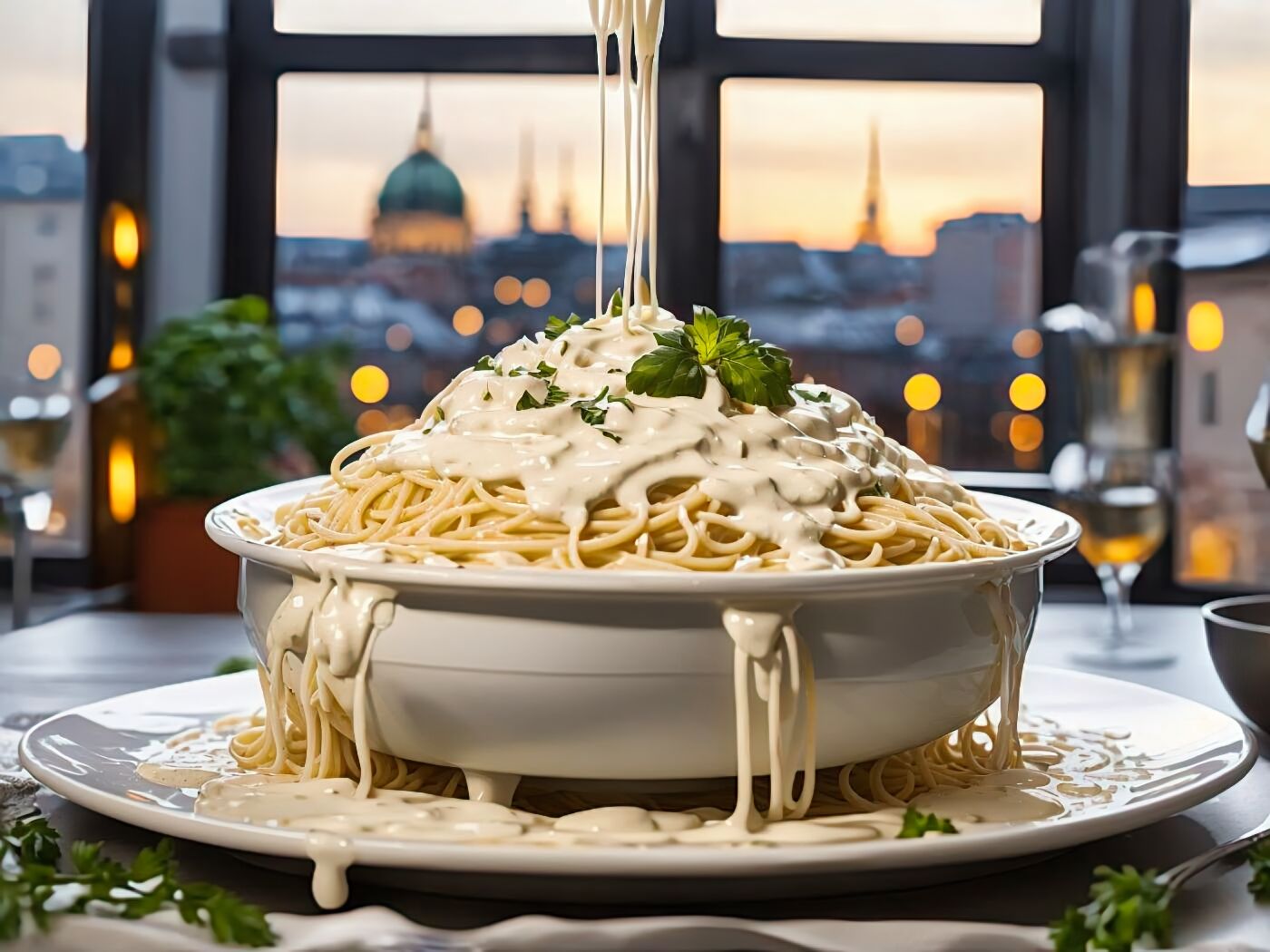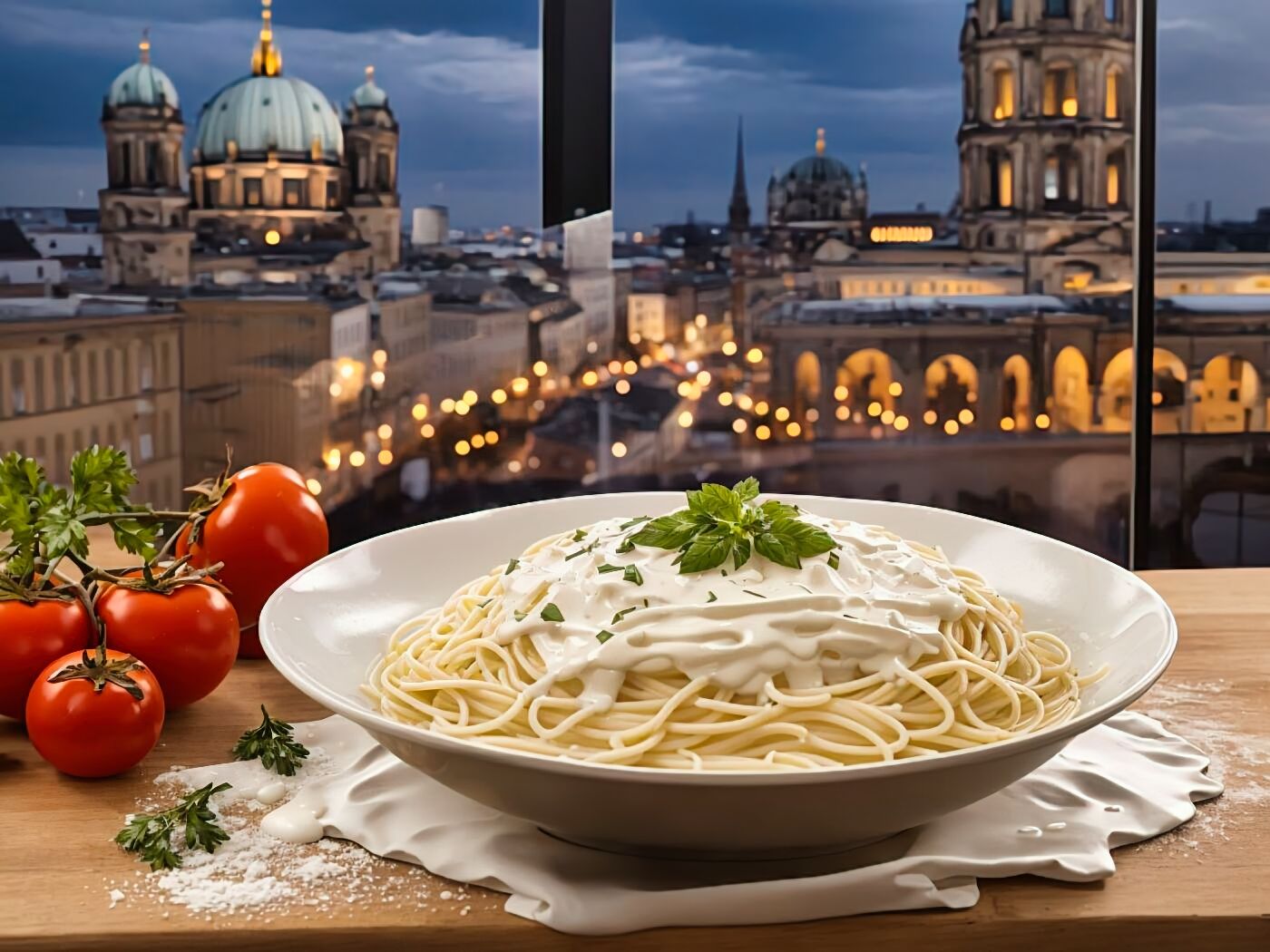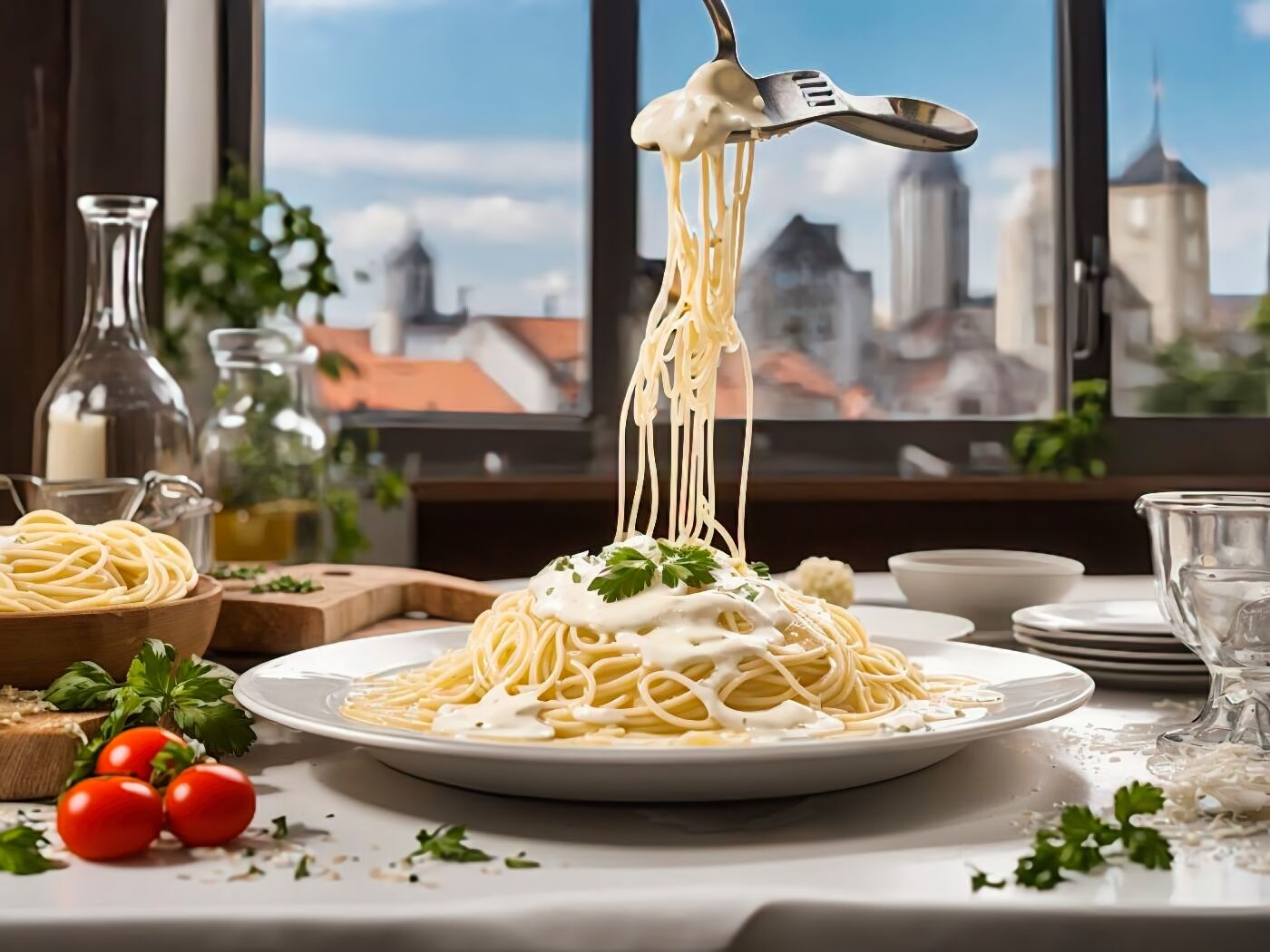
The German Spaghetti Recipe is a delicious dish that combines the flavors of Italy and Germany. It is a fusion of two culinary traditions, resulting in a unique and flavorful meal. This recipe offers a delightful combination of pasta, meat, and various seasonings.
Want more ideas to round-out your Brazilian Recipes Box?
A lot of great options are in these posts!
25 Easy Authentic German Food Recipes
The German Spaghetti Recipe typically includes spaghetti noodles, ground meat such as beef or pork, onions, garlic, and a medley of spices. The dish is often garnished with parsley or grated cheese. The noodles are cooked until they are tender but still have a slight bite to them. The meat is browned and seasoned with a blend of spices to enhance its taste.
The German Spaghetti Recipe boasts a rich and savory flavor profile. The combination of the tender pasta and well-seasoned meat creates a satisfying and hearty meal. The onions and garlic add a delightful aroma and depth of flavor to the dish. The addition of parsley or grated cheese provides a finishing touch that adds a hint of freshness and richness.
In terms of versatility, the German Spaghetti Recipe offers numerous options for customization. You can experiment with different types of meat, such as turkey or veal, to suit your taste preferences. Additionally, you can adjust the seasoning and spices to create a flavor profile that best suits your palate.
You May Want to Join The World Recipes With Our Big Escape
Share your own recipes in our Facebook Group. Find recipes from all over the world. Learn more about International Cuisine and how you can surprise your family with new and exciting foods from all over the world.
For More Photos Visit Our Instagram at World Recipes Daily
Nutritionally, the German Spaghetti Recipe provides a balanced meal. The pasta offers a good source of carbohydrates for energy, while the meat provides protein, essential for muscle growth and repair. The onions and garlic contain vitamins and minerals that contribute to overall health. However, it is important to note that the specific nutritional content may vary depending on the ingredients and preparation method used.
Overall, the German Spaghetti Recipe is a flavorful and versatile dish that combines the best of Italian and German cuisines. Its rich flavors, customizability, and nutritional advantages make it a delightful choice for a satisfying meal.

How To Make Our German Spaghetti Recipe
Ingredients (8 Servings)
16 oz spaghetti, uncooked
1 lb bacon, chopped
2 lb bratwurst sausage, sliced
2 yellow onion, thinly sliced
2 cup mushrooms, baby Bella or button thinly sliced
16 oz beer
6 tablespoons butter, unsalted
6 tablespoons all-purpose flour
4 cups milk
2 cup cheddar cheese, grated
4 tablespoons mustard, stoneground
2 teaspoon vinegar, apple cider
1 cup sour cream
2 tablespoon chives, chopped
Kosher salt
black pepper, freshly ground to taste
Instructions
1. Boil the spaghetti:
a. Fill a large pot with water and bring it to a boil.
b. Add a pinch of salt to the boiling water.
c. Carefully add the spaghetti to the pot.
d. Cook the spaghetti according to the package instructions until al dente.
e. Drain the cooked spaghetti and set it aside.
2. Cook the bacon and bratwurst:
a. In a large skillet, cook the chopped bacon over medium heat until crispy.
b. Use a slotted spoon to transfer the cooked bacon to a plate lined with paper towels, leaving the bacon grease in the skillet.
c. In the same skillet, add the sliced bratwurst sausage.
d. Cook the bratwurst until browned and cooked through.
e. Remove the cooked bratwurst from the skillet and set it aside.
3. Sauté the onions and mushrooms:
a. In the same skillet, add the thinly sliced onions to the bacon grease.
b. Sauté the onions over medium heat until they become translucent and lightly caramelized.
c. Add the sliced mushrooms to the skillet and continue sautéing until they become tender and golden brown.
d. Remove the onions and mushrooms from the skillet and set them aside.
4. Prepare the beer cheese sauce:
a. In a medium saucepan, melt the unsalted butter over medium heat.
b. Stir in the all-purpose flour and cook for a minute to make a roux.
c. Gradually whisk in the milk, ensuring there are no lumps.
d. Cook the mixture, stirring constantly, until it thickens and comes to a gentle boil.
e. Reduce the heat to low and stir in the grated cheddar cheese until melted and smooth.
f. Add the stoneground mustard, apple cider vinegar, and sour cream to the sauce, stirring well to combine.
g. Season the sauce with salt and freshly ground black pepper to taste.
5. Combine the ingredients:
a. In a large pot or skillet, combine the cooked spaghetti, cooked bacon, cooked bratwurst, sautéed onions, and mushrooms.
b. Pour the beer cheese sauce over the ingredients and gently toss everything together until well coated.
c. Cook the combined mixture over low heat for a few minutes, stirring occasionally, to allow the flavors to meld together.
6. Serve the German Spaghetti:
a. Garnish the German Spaghetti with freshly chopped chives.
b. Divide the dish into individual servings and serve it hot.
c. Enjoy this flavorful and hearty German Spaghetti dish!
Prep Time: 45 Minutes
Cooking Time: 20 Minutes

Pots, Pan and Cooking Equipment Needed for the German Spaghetti Recipe
Large pot for boiling spaghetti
Large skillet for cooking bacon, bratwurst, onions, and mushrooms
Medium saucepan for preparing the beer cheese sauce
Whisk for combining the ingredients in the beer cheese sauce
Slotted spoon for removing cooked bacon
Serving dish or individual plates for serving the German Spaghetti
Knife for chopping ingredients
Cutting board for preparing ingredients
Best Way to Store Leftovers From the the German Spaghetti Recipe
a. Transfer any leftover German Spaghetti to an airtight container.
b. Ensure the container is large enough to hold the leftovers without squishing them.
c. Place the container in the refrigerator to cool.
d. Label the container with the date to keep track of freshness.
e. Store the leftovers in the refrigerator for up to 3-4 days.
Tips and Tricks For Easier Creation
Cook the bacon in batches to ensure it becomes crispy and evenly cooked.
Slice the bratwurst sausage at a slight angle to add visual appeal to the dish.
Use a non-stick skillet to prevent ingredients from sticking during cooking.
Pre-slice the onions and mushrooms to save time during the sautéing process.
Grate the cheddar cheese before starting the beer cheese sauce for easy melting.
Side Dishes and Desserts For the the German Spaghetti Recipe
Crusty garlic bread
Mixed green salad with a tangy vinaigrette
Roasted vegetables, such as Brussels sprouts or asparagus
Steamed broccoli or green beans with a squeeze of lemon
How To Serve the German Spaghetti Recipe
a. Use a large spoon or tongs to portion out the German Spaghetti onto plates.
b. Ensure each serving includes a generous amount of the bacon, bratwurst, onions, and mushrooms.
c. Drizzle some of the beer cheese sauce over each serving.
d. Garnish with freshly chopped chives for added freshness and color.
e. Serve the German Spaghetti hot, while the flavors are at their best.
f. Accompany the dish with any desired side dishes from the suggested list.
Dietary Substitution For the German Spaghetti Recipe
1. Vegan Options for the German Spaghetti Recipe:
a. Substitute bacon with tempeh or plant-based bacon alternative.
b. Use vegan bratwurst or plant-based sausage instead of bratwurst sausage.
c. Replace dairy milk with unsweetened almond milk or other non-dairy milk.
d. Choose vegan cheese or nutritional yeast as a substitute for cheddar cheese.
e. Use vegan butter or vegetable oil instead of unsalted butter.
f. Replace sour cream with dairy-free sour cream or cashew cream.
g. Omit bacon and sausage for a vegetable-centric version of the dish.
2. Gluten-Free Options for the German Spaghetti Recipe:
a. Choose gluten-free spaghetti made from rice, corn, or other gluten-free grains.
b. Ensure bacon and bratwurst are gluten-free and do not contain any added gluten fillers or seasonings.
c. Use gluten-free all-purpose flour in place of regular all-purpose flour.
d. Check the label on the mustard to ensure it is gluten-free or use a gluten-free alternative.
e. Opt for a gluten-free beer or substitute it with gluten-free vegetable broth.
f. Verify that the apple cider vinegar is gluten-free or use a gluten-free vinegar option.
g. Double-check all ingredients to ensure they are gluten-free and suitable for your dietary needs.
3. Vegetarian Options for the German Spaghetti Recipe:
a. Omit bacon and use vegetarian bacon bits or smoked paprika for a smoky flavor.
b. Replace bratwurst with vegetarian sausage or plant-based protein alternative.
c. Stick to vegetable-based toppings like caramelized onions and sautéed mushrooms.
d. Use vegetable broth instead of German beer for added flavor.
e. Opt for a vegetarian-friendly cheese or skip it altogether.
f. Replace stoneground mustard with a vegetarian-friendly mustard option.
g. Customize the dish with additional vegetables such as bell peppers or zucchini.
4. Mediterranean Diet Options for the German Spaghetti Recipe:
a. Choose whole wheat or whole grain spaghetti for added fiber.
b. Use turkey bacon or lean turkey sausage instead of regular bacon and bratwurst.
c. Enhance the dish with Mediterranean ingredients like sun-dried tomatoes or olives.
d. Replace the beer with a low-sodium vegetable broth or red wine.
e. Use olive oil in place of unsalted butter for a heart-healthy fat source.
f. Incorporate feta cheese or goat cheese instead of cheddar cheese.
g. Top with fresh herbs like basil or oregano for a Mediterranean touch.
5. Keto Diet Options for the German Spaghetti Recipe:
a. Replace spaghetti with zucchini noodles (zoodles) or spaghetti squash for a low-carb alternative.
b. Use turkey bacon or sugar-free bacon in place of regular bacon.
c. Opt for sugar-free bratwurst or other low-carb sausage options.
d. Choose a low-carb beer or use chicken broth instead.
e. Replace all-purpose flour with almond flour or coconut flour for the beer cheese sauce.
f. Use full-fat cheddar cheese or a combination of cheddar and cream cheese.
g. Garnish with keto-friendly herbs like parsley or chives.
6. Heart Healthy Diet Options for the German Spaghetti Recipe:
a. Use whole wheat or whole grain spaghetti for added fiber.
b. Opt for lean turkey bacon or turkey sausage as a healthier alternative.
c. Sauté onions and mushrooms with heart-healthy olive oil instead of butter.
d. Choose a low-sodium vegetable broth or light beer instead of regular beer.
e. Select reduced-fat or low-fat cheddar cheese for the beer cheese sauce.
f. Use stoneground mustard without added sugars or preservatives.
g. Serve with a side of steamed vegetables or a mixed green salad for added nutrition.
7. Paleo Options for the German Spaghetti Recipe:
a. Replace spaghetti with zucchini noodles (zoodles) or spaghetti squash.
b. Use sugar-free, nitrate-free, and preservative-free bacon or sausage.
c. Saute onions and mushrooms in coconut oil or ghee.
d. Replace the beer with homemade bone broth or vegetable broth.
e. Opt for paleo-friendly flour alternatives like almond flour or tapioca flour.
f. Use dairy-free cheese or omit cheese altogether.
g. Enhance the dish with fresh herbs like basil or cilantro.
8. Low Carb Options for the German Spaghetti Recipe:
a. Substitute spaghetti with shirataki noodles or spaghetti squash for a low-carb choice.
b. Choose turkey bacon or lean chicken sausage instead of regular bacon and bratwurst.
c. Use low-carb vegetables like zucchini or cauliflower instead of onions and mushrooms.
d. Replace beer with chicken or vegetable broth to reduce carb content.
e. Use coconut flour or almond flour instead of all-purpose flour for the sauce.
f. Opt for low-fat or reduced-fat cheddar cheese.
g. Top with fresh herbs like parsley or basil to add flavor without adding carbs.
9. Whole30 Options for the German Spaghetti Recipe:
a. Replace spaghetti with zucchini noodles (zoodles) or spaghetti squash.
b. Choose sugar-free, nitrate-free bacon or sausage that complies with Whole30 guidelines.
c. Saute onions and mushrooms in ghee or coconut oil.
d. Use compliant mustard and vinegar in the sauce.
e. Replace beer with chicken or vegetable broth.
f. Omit cheese and sour cream for a dairy-free version.
g. Customize the dish with Whole30-approved herbs and spices.
for the German Spaghetti Recipe:: for the German Spaghetti Recipe:
a. Use whole wheat or whole grain spaghetti for added fiber and lower points value.
b. Select lean turkey bacon or low-fat turkey sausage to reduce points.
c. Opt for cooking spray or a small amount of olive oil instead of butter.
d. Replace beer with low-sodium vegetable broth for fewer points.
e. Use reduced-fat or fat-free cheddar cheese to reduce points.
f. Use stoneground mustard without added sugars or fats.
g. Serve with a side of steamed vegetables or a mixed green salad to increase nutrient density.
11. Low Fat Options for the German Spaghetti Recipe:
a. Choose whole wheat or whole grain spaghetti for added fiber and lower fat content.
b. Use turkey bacon or lean turkey sausage instead of regular bacon and bratwurst.
c. Saute onions and mushrooms in cooking spray or a small amount of olive oil.
d. Replace beer with low-sodium vegetable broth to reduce fat content.
e. Use reduced-fat or fat-free cheddar cheese for the beer cheese sauce.
f. Opt for stoneground mustard without added oils or fats.
g. Serve with a side of steamed vegetables or a mixed green salad for a low-fat option.
12. Vegetable Variations for the German Spaghetti Recipe:
a. Substitute spaghetti with spiralized carrots or sweet potato noodles for a veggie-centric version.
b. Omit bacon and sausage and focus on sautéed onions and mushrooms as the main flavor.
c. Use vegetable broth or a vegetable-based sauce instead of beer for added depth.
d. Enhance the dish with additional vegetables like bell peppers, zucchini, or spinach.
e. Add roasted garlic for a rich and savory taste.
f. Top with fresh herbs like basil or thyme to elevate the vegetable flavors.
g. Serve with a side of steamed or roasted vegetables for a wholesome vegetable-centric meal.
Please note that the given substitutions are general suggestions, and individual dietary needs and preferences may vary. It’s always recommended to check labels, choose quality ingredients, and consult with a healthcare professional or registered dietitian for personalized advice.

FAQ About the German Spaghetti Recipe
What is the German Spaghetti Recipe?
The German Spaghetti Recipe is a delicious fusion dish that combines Italian spaghetti with German flavors. It features spaghetti noodles, bacon, bratwurst sausage, onions, mushrooms, beer-infused cheese sauce, and various seasonings.
How long does it take to cook the German Spaghetti Recipe?
The estimated cooking time for the German Spaghetti Recipe is approximately 30 minutes. However, this may vary depending on individual cooking techniques and the heat used.
Can I make substitutions in the German Spaghetti Recipe?
Yes, you can make substitutions in the German Spaghetti Recipe to suit your dietary preferences or restrictions. For example, you can choose vegetarian or vegan alternatives, gluten-free options, or opt for low-fat ingredients.
How many servings does the German Spaghetti Recipe yield?
The German Spaghetti Recipe typically serves 8 people. However, you can adjust the quantities according to your specific needs or the number of guests you are serving.
Are there any health benefits associated with the German Spaghetti Recipe?
The German Spaghetti Recipe offers a balanced mix of carbohydrates, protein, and fats. It provides energy from the pasta, protein from the meat, and essential nutrients from the vegetables. However, it’s important to note that the specific health benefits may vary depending on the ingredients used and individual dietary considerations.
Final Thoughts
The German Spaghetti Recipe is a delightful fusion dish that combines the flavors of Italian spaghetti with German influences. It features tender spaghetti noodles, savory bacon, flavorful bratwurst sausage, onions, mushrooms, and a delectable beer-infused cheese sauce. The dish offers a perfect balance of textures and tastes, with the noodles providing a satisfying bite, the meat adding richness, and the sauce tying everything together with its creamy and tangy notes.
What makes the German Spaghetti Recipe truly remarkable is its versatility. While the traditional recipe is already delicious on its own, you can customize it to suit various dietary preferences and needs. Whether you’re following a vegetarian, gluten-free, or low-carb diet, there are substitutions and modifications available for you to enjoy this dish.
In terms of nutritional benefits, the German Spaghetti Recipe provides a good mix of essential nutrients. The pasta offers carbohydrates for energy, while the meat contributes protein for muscle growth and repair. Additionally, the onions, mushrooms, and other vegetables provide vitamins, minerals, and dietary fiber.
Overall, the German Spaghetti Recipe is a flavorful and versatile dish that is sure to please a crowd. Its combination of Italian and German flavors, along with its adaptability to different dietary preferences, makes it a fantastic choice for any occasion. So gather your ingredients, follow the recipe, and savor the deliciousness of this unique culinary creation.
German Spaghetti Recipe
Ingredients
Equipment
Method
- a. Fill a large pot with water and bring it to a boil.
- b. Add a pinch of salt to the boiling water.
- c. Carefully add the spaghetti to the pot.
- d. Cook the spaghetti according to the package instructions until al dente.
- e. Drain the cooked spaghetti and set it aside.
- a. In a large skillet, cook the chopped bacon over medium heat until crispy.
- b. Use a slotted spoon to transfer the cooked bacon to a plate lined with paper towels, leaving the bacon grease in the skillet.
- c. In the same skillet, add the sliced bratwurst sausage.
- d. Cook the bratwurst until browned and cooked through.
- e. Remove the cooked bratwurst from the skillet and set it aside.
- a. In the same skillet, add the thinly sliced onions to the bacon grease.
- b. Sauté the onions over medium heat until they become translucent and lightly caramelized.
- c. Add the sliced mushrooms to the skillet and continue sautéing until they become tender and golden brown.
- d. Remove the onions and mushrooms from the skillet and set them aside.
- a. In a medium saucepan, melt the unsalted butter over medium heat.
- b. Stir in the all-purpose flour and cook for a minute to make a roux.
- c. Gradually whisk in the milk, ensuring there are no lumps.
- d. Cook the mixture, stirring constantly, until it thickens and comes to a gentle boil.
- e. Reduce the heat to low and stir in the grated cheddar cheese until melted and smooth.
- f. Add the stoneground mustard, apple cider vinegar, and sour cream to the sauce, stirring well to combine.
- g. Season the sauce with salt and freshly ground black pepper to taste.
- a. In a large pot or skillet, combine the cooked spaghetti, cooked bacon, cooked bratwurst, sautéed onions, and mushrooms.
- b. Pour the beer cheese sauce over the ingredients and gently toss everything together until well coated.
- c. Cook the combined mixture over low heat for a few minutes, stirring occasionally, to allow the flavors to meld together.
- a. Garnish the German Spaghetti with freshly chopped chives.
- b. Divide the dish into individual servings and serve it hot.
- c. Enjoy this flavorful and hearty German Spaghetti dish!


